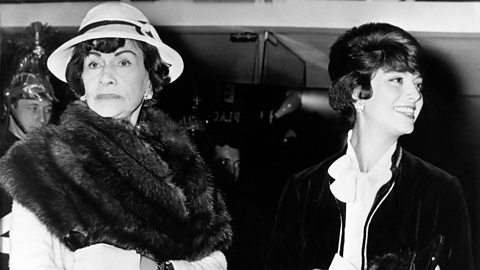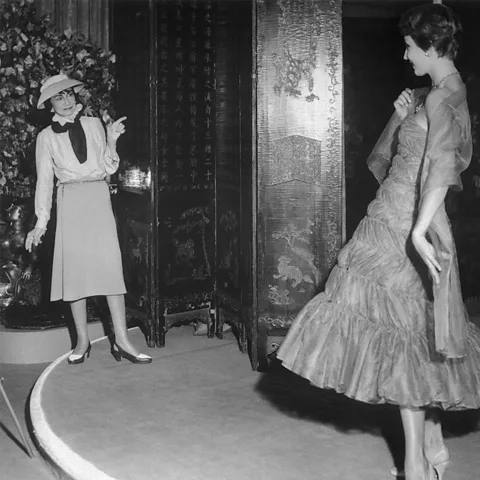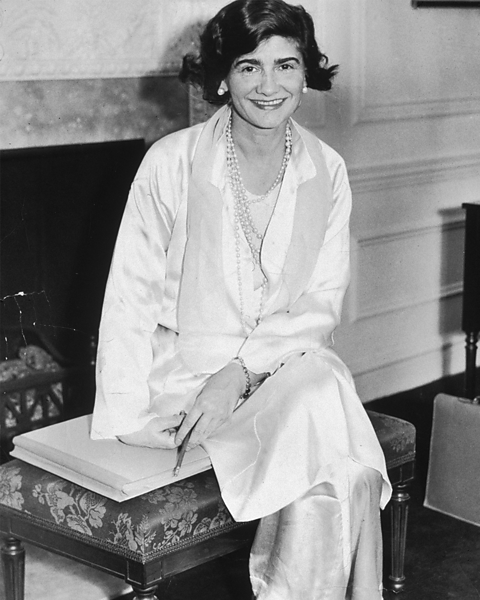The true story of Coco Chanel's childhood: In search of Gabrielle
 FPG/Getty Images
FPG/Getty ImagesUntil Gabrielle Chanel became Coco, she left barely a footprint. However, by tracing her history through rural , Justine Picardie has been able to piece together her childhood.
The butcher was the only place in the Auvergne village of Courpière that showed any signs of life when I visited on an August afternoon. A handful of half-timbered houses and shuttered windows, this sleepy little place was allegedly once home to one of the world's most famous fashion designers: Coco, née Gabrielle, Chanel. Tracking down anything concrete was proving difficult, however, and records of her early life were no more substantial than a whiff of her No. 5 in the breeze.
The lack of clarity about where Chanel came from doesn't stop people thinking they know who she was. Part of this is due to media misrepresentation. Feuds with rival designers (thanks to the Broadway musical, Coco, starring Katharine Hepburn). Rumours that her older sister Julia took her own life, and that Julia's son André was in fact Coco Chanel's illegitimate child. Numerous reports of her having been a Nazi collaborator.
Google "Chanel" and you'll be confronted with 50 different versions of her life. Without evidence for any of the above claims, how do we know which is the truth?
"I think her home was down by the campsite," said one customer in the Courpière butcher shop.
"No, it was the house that belongs to the psychiatrist," said another with confidence.
"Ah bon, Coco Chanel lived here?!" said the butcher herself in surprise.
 ullstein bild Dtl/Contributor/Getty Images
ullstein bild Dtl/Contributor/Getty ImagesIt had been like this everywhere I went, a series of lost Auvergnian towns in an area of central known as la diagonale du vide (the empty diagonal), far from the typical tourist track. Towns like Mont-Dore, Brive-la-Gaillarde, Moulins, Thiers. Each delivered no more information than I'd been able to piece together online. Even the spa city of Vichy, where Chanel had worked as a water girl, serving glasses of Vichy's famous sulphurous waters to visitors on retreat, gave me nothing. The little black dress that she's credited with inventing may have permeated couture worldwide; the ubiquitous signature scent, Chanel No. 5, available in every airport duty-free and cruise liner boutique – but until Gabrielle Chanel became Coco, she seemed to have left barely a footprint.
It's particularly difficult to unpick as Chanel notoriously told many different stories to different journalists who interviewed her during the course of her life, and those stories, especially those relating to her childhood, often didn't add up. But as the first major exhibition of Chanel's work in the UK (Gabrielle Chanel: Fashion Manifesto) opens at the V&A museum on 16 September 2023, it's a reminder that the line between art and artist is often inseparable.
"Chanel's aesthetic may be black and white, but her life is filled with shades of grey," said Justine Picardie, an author, fashion writer and former editor-in-chief of Harper's Bazaar. "I tend not to use the word 'lie' about Chanel. She had to create a series of stories that were bearable. The truth about her childhood was too unbearable and I think she wanted to leave it as far behind her as possible."
Picardie has spent 25 years researching the designer, and her biography, Coco Chanel: The Legend and the Life, has been updated and republished to coincide with the new exhibit, and includes much more detail on Chanel's earlier life.
 Bettmann/Contributor/Getty Images
Bettmann/Contributor/Getty Images"The reason I've done such a major new edition of my book is because I discovered so much new material. Chanel constantly has the capacity to astonish me," said Picardie.
In the footsteps of young Chanel:
Picardie's own travels took her to Aubazine, the convent orphanage where Chanel and her sisters were placed when abandoned by their father, and to Chanel's former apartment in Rue Cambon, Paris. She also met with people who'd known Chanel personally, among them her close friend Claude Delay, her great-niece Gabrielle Labrunie and an elderly woman from Aubazine.
What Picardie discovered is that Gabrielle Chanel was born in Saumur on 19 August 1883, the illegitimate child of Eugénie (Jeanne) Dévolles and Henri-Albert Chanel, who were then unmarried. Due to a clerical error, she was listed as 'Chasnel' on her birth certificate. Her parents already had one child, Julia, born under a year before Chanel. Her father, who seemingly was to spend the rest of his life on the run from his family, was not present for either birth.
Henri-Albert and Jeanne eventually married when Gabrielle was 15 months old, not that it would make her father any more present in her life. They had four more children over the seven years that followed, although one never made it past infancy. The surviving children were Chanel's little sister Antoinette, and brothers Lucien and Alphonse.
"Her father was itinerant, so there's these tantalising traces of her," said Picardie. "But it's important to say we don't know exactly her movements as a child, because they were constantly moving between small market towns."
One concrete date is in 1895. Chanel's mother Jeanne appears on the death records in Brive-la-Gaillarde, found dead in her bed on a freezing morning. It's unclear whether any of her children were present at the time. In interviews with journalists, Chanel claimed she was six years old. She was in fact 11, and these inaccuracies around her age continued throughout her life.
 New York Times Co./Contributor/Getty Images
New York Times Co./Contributor/Getty ImagesAfter Jeanne's death, the records become muddy once again. Some showed Chanel and her sisters as living with family in Thiers, a medieval town with tightly packed half-timber buildings in Auvergne, and Chanel herself is quoted in interviews as saying she'd been sent to live with aunts. That may be the case, but if so, it was temporary as in 1896 Chanel and her sisters were placed in an orphanage run by nuns in Aubazine, abandoned by their father. They would stay here until Chanel turned 18. It's thought that the austerity of Chanel's years in Aubazine led to her lifelong predilection for monochrome fashion designs.
"There was still an oral history in Aubazine through the nuns," explained Picardie. "I met an elderly lady who'd been born in the village; she must have been in her 80s or even 90s. This woman had met Chanel, who used to return to Aubazine to visit one nun in particular, although she'd never spend the night."
At 18 years old, Chanel obtained a charity place at the Notre-Dame boarding school in Moulins. When she left the school, the Mother Superior of the school found her and her sister Antoinette employment as seamstresses in a draper's shop in town. It was here that she began to have encounters with army officers as several regiments were garrisoned in Moulins. Gabrielle and Antoinette also began to sing in concerts for the local barracks. One of the songs in Gabrielle's repertoire was "Qui qu'a vu Coco">window._taboola = window._taboola || []; _taboola.push({ mode: 'alternating-thumbnails-a', container: 'taboola-below-article', placement: 'Below Article', target_type: 'mix' });
